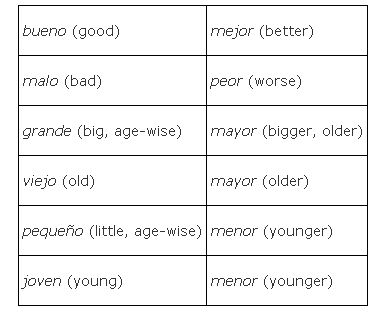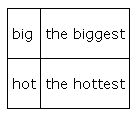When an adjective has only one syllable, the English language creates a special form of the adjective to compare one noun to another: By adding the suffix
‐er to an adjective, you imply “more.” In a complete sentence, this comparative form of the adjective is followed by the word “than.”
- Mario is tall. Shelly is taller than Mario.
- I am smart. You are smarter than I.
However, when an adjective is more than one syllable, you must use the adverbs “more” or “less,” followed by the adjective and the word “than,” to create a comparison.
- Lisa is intelligent. Erin is more intelligent than Lisa.
- Danny is annoying. Paul is less annoying than Danny.
All comparisons in Spanish are created like the longer adjectives above. The basic adjective form is used with a similar sentence structure to express a comparison. The adverb más means “more” and menos means “less.” The formula to indicate comparison is constructed by using these two modifiers followed by an adjective, then the conjunction que, as illustrated below. Notice that the adjective is used to reflect the gender and number of the first noun being compared.
- (1st noun) es más (adjective) que (2nd noun)
- (1st noun) is more (adjective) than (2nd noun) or (1st noun) is (adjective + er) than (2nd noun)
- Marta es más alta que Marco.
- Marta is more tall than Marco or Marta is taller than Marco.
- (1st noun) es menos (adjective) que (2nd noun)
- (1st noun) is less (adjective) than (2nd noun)
- Memo y Cristóbal son menos prácticos que sus hermanas.
- Memo and Cristóbal are less practical than their sisters.
One important exception to the comparative formulas is when the second noun is a number. In these types of sentences, there is often a verb other than ser, and the que is replaced by de, as you can see in the examples below.
- Zobeida tiene más de 30 pares de zapatos.
- Zobeida has more than 30 pairs of shoes.
- Yo necesito menos de 10 voluntarios para tener éxito.
- I need less than 10 volunteers to be successful.
Sometimes, the point of a comparison is to indicate that the two nouns are the same.
- (1st noun) es tan (adjective) como (2nd noun)
- (1st noun) is as (adjective) as (2nd noun)
- La criada es tan importante como el abogado.
- The maid is as important as the lawyer.
- Tus amigos son tan importantes como tu profesión.
- Your friends are as important as your work.
A few adjectives in Spanish have irregular comparative and superlative forms. Rather than using más or menos with the basic adjective, the irregular form is used.

In high school, students often select “senior superlatives” such as “best smile,” “nicest,” or “most likely to succeed.” If an adjective has only one syllable, the superlative form is created by adding the suffix ‐est. Notice that superlatives usually include the definite article “the.”

With longer adjectives and when you want to express “least,” there is no special adjective form. In these cases, the adverb “most” or “least” is placed in front of the adjective.

The Spanish language uses a formula to create superlatives that includes the words más or menos, similar to the comparatives above. To make these adverbs indicate the absolute extremes “most” and “least” (rather than “more” or “less”), the appropriate definite article (el, la, los, or las) is used.
- Este libro es el más aburrido que he leído .
- This is the most boring book that I have read.
- Esa revista es la más interesante en la tienda.
- That magazine is the most interesting in the store.
When a comparison is followed by a prepositional phrase that limits it to a certain group, English uses “in” but Spanish uses de.
- Catalina es la menos interesada de la clase.
- Catalina is the least interested one in the class.
- Granada es la ciudad más bonita de España.
- Granada is the most beautiful city in Spain.
In Spanish, there is a type of superlative adjective form that makes that adjective even more extreme. When the Spanish suffix ‐ísimo added to an adjective, it has the same effect as placing the word “very” in front of an English adjective. Like any adjective ending in ‐o, these superlatives have four forms to match the gender and number of the nouns they modify. Notice in the examples below that an adjective that ends in ‐go will change to gu in front of the ‐ísimo ending. Also, a ‐co ending changes to qu and a final ‐z changes to c.

|
|
|
|
|
|
|
|
|
|
|
|
|
|
|
|
|
|
|
|
|
|
|
|
|
|
|
|